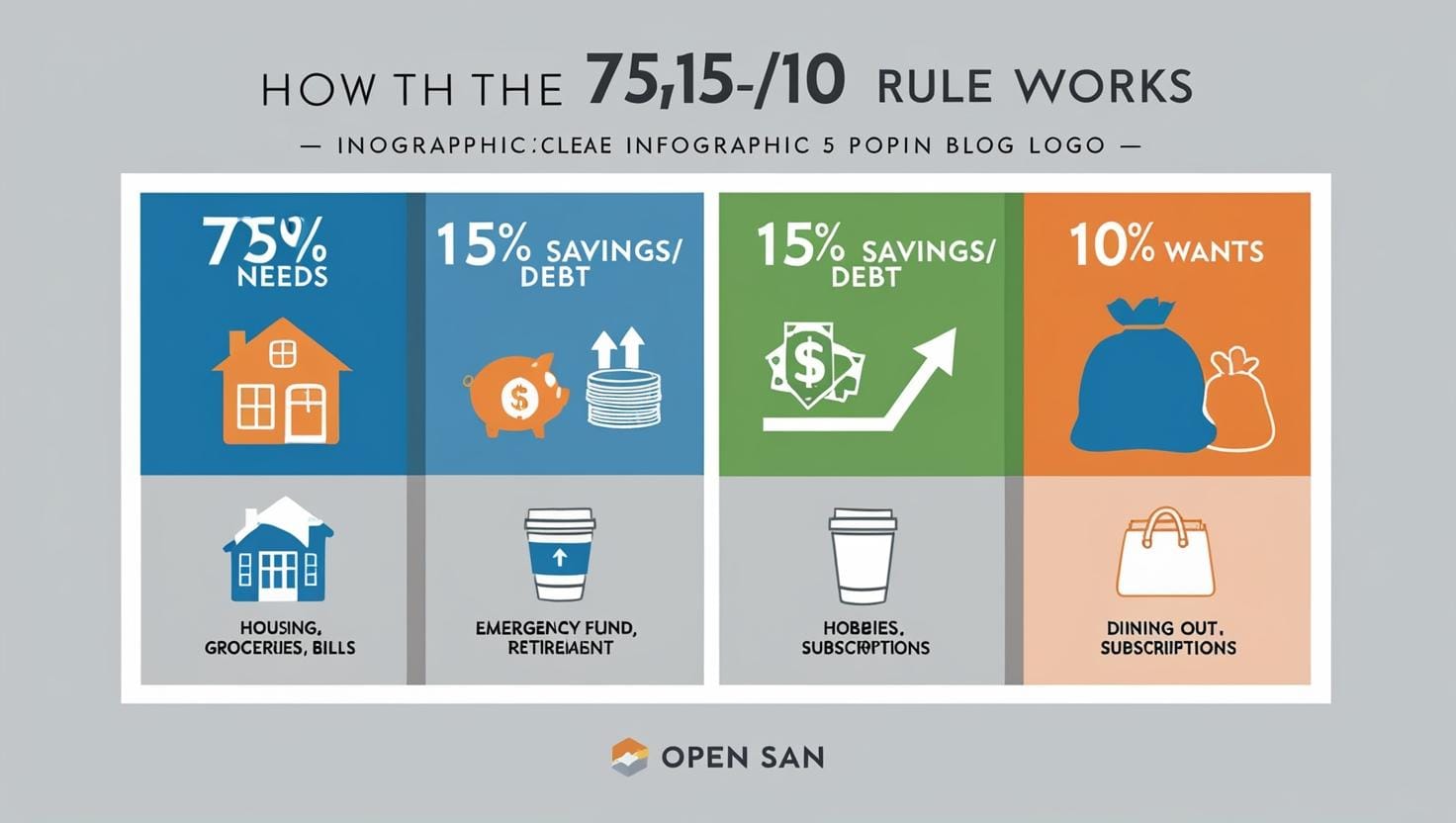Discover the 75/15/10 rule—a simple budgeting method to save 15% of your income, crush debt, and still enjoy life. Learn if it’s right for you!”
Are you overwhelmed by budgeting methods? From the 50/30/20 rule to zero-based budgeting, it’s easy to get lost in the noise. But what if there’s a simpler way to manage your money without spreadsheets or apps? Enter the 75/15/10 rule—a minimalist, percentage-based strategy that prioritizes essentials, savings, and guilt-free spending.
In this guide, you’ll learn:
- What the 75/15/10 rule is (and how it compares to other budgeting frameworks)
- Step-by-step instructions to implement it
- Who this method works best for (and who should avoid it)
- How to customize it for your unique financial goals
What Is the 75/15/10 Rule?
The 75/15/10 rule is a percentage-based budgeting system that divides your after-tax income into three categories:
- 75% for Needs: Essential expenses like housing, utilities, groceries, insurance, and minimum debt payments.
- 15% for Savings & Debt Repayment: Emergency funds, retirement accounts (e.g., 401(k)), and extra debt payments beyond the minimum.
- 10% for Wants: Non-essential spending like dining out, travel, hobbies, or subscriptions.
Unlike the popular 50/30/20 rule, the 75/15/10 method prioritizes aggressive saving and debt payoff while tightening spending on wants. It’s ideal for people who want to:
- Escape paycheck-to-paycheck cycles
- Pay off debt faster
- Build wealth without tracking every dollar

How the 75/15/10 Rule Works: A Real-Life Example
Let’s say your monthly take-home pay is $4,000:
| Category | Percentage | Amount | Examples |
|---|---|---|---|
| Needs | 75% | $3,000 | Rent, utilities, groceries, insurance, debt |
| Savings/Debt | 15% | $600 | Emergency fund, retirement, extra debt payments |
| Wants | 10% | $400 | Dining out, travel, hobbies, subscriptions |
Why it works: It creates clear boundaries, reduces decision fatigue, and forces you to prioritize long-term goals over lifestyle inflation.
Pros and Cons of the 75/15/10 Rule
Pros
Simplicity: No micromanaging categories—just three buckets.
Debt Focus: Allocates 15% to crushing debt or building savings.
Flexibility: Works for variable incomes (e.g., freelancers) if you adjust percentages monthly.
Cons
Rigid for High-Cost Areas: If housing eats 50% of your income (common in cities like NYC or SF), sticking to 75% for all needs is tough.
Limited “Fun Money”: 10% for wants may feel restrictive if you value experiences or hobbies.
Not for Low Incomes: If essentials exceed 75%, this method isn’t sustainable.
75/15/10 vs. Other Budgeting Methods
Here’s a quick comparison of popular budgeting frameworks:
| Budgeting Method | Needs | Wants | Savings/Debt | Best For |
|---|---|---|---|---|
| 75/15/10 Rule | 75% | 10% | 15% | Aggressive savers, debt repayment |
| 50/30/20 Rule | 50% | 30% | 20% | Balanced lifestyles, moderate savers |
| Zero-Based Budget | Variable | Variable | Variable | Detail-oriented planners |
| Pay-Yourself-First | Flexible | Flexible | Priority | Minimalists, irregular income earners |
Winner: The 75/15/10 rule shines for debt payoff and frugal spenders who want to automate savings.
How to Customize the 75/15/10 Rule for Your Goals
- Adjust Percentages:
- If you earn $6k/month but live in a high-cost area, try 80/10/10.
- If debt-free, shift the 15% to investments (e.g., 75/20/5).
- Use Hybrid Strategies:
- Pair it with the envelope system for cash-based spending on wants.
- Combine with sinking funds for irregular expenses (e.g., car repairs).
- Automate It:
- Direct deposit savings/debt payments to separate accounts.
- Use apps like Qapital or Digit to automate the 15% savings rule.
Who Should Use the 75/15/10 Rule?
- Debt Repayment Warriors: Perfect for paying off credit cards or student loans.
- Minimalists: If you hate tracking 20+ categories, this simplifies life.
- High Earners with Discipline: Those who can keep lifestyle inflation in check.
Avoid it if:
- Your essential expenses exceed 75% of income.
- You’re building a business or have irregular income.
Step-by-Step Guide to Start the 75/15/10 Budget
- Calculate After-Tax Income: Include salary, side hustles, and passive income.
- Categorize Essentials: List needs (rent, utilities, groceries, insurance).
- Trim Excess: If needs exceed 75%, cut costs (e.g., refinance debt, downsize housing).
- Automate Savings: Send 15% to savings/debt accounts on payday.
- Track Wants: Use a debit card or app to cap spending at 10%.
Pro Tip: Review every 3 months. Life changes—so should your budget!
FAQs
Q: Is the 75/15/10 rule better than the 50/30/20?
A: It depends! The 75/15/10 is better for aggressive savers, while 50/30/20 offers more flexibility for wants.
Q: What if my needs exceed 75% of my income?
A: Prioritize increasing income (side hustles, raises) or reduce fixed costs (cheaper housing, refinancing debt).
Q: Can I use the 75/15/10 rule with a variable income?
A: Yes! Calculate percentages based on your lowest monthly income to stay safe.
Conclusion: Is the 75/15/10 Rule Right for You?
The 75/15/10 rule isn’t a one-size-fits-all solution, but it’s a powerful tool for simplifying finances and accelerating savings. If you’re tired of complex budgets and want to focus on big wins (like debt freedom or retirement), give it a 3-month trial.
Ready to start? Share this post, bookmark it, and tag someone who needs a budget reset!
COMMENT WHICH BUDGETING METHOD DO YOU USE ?
